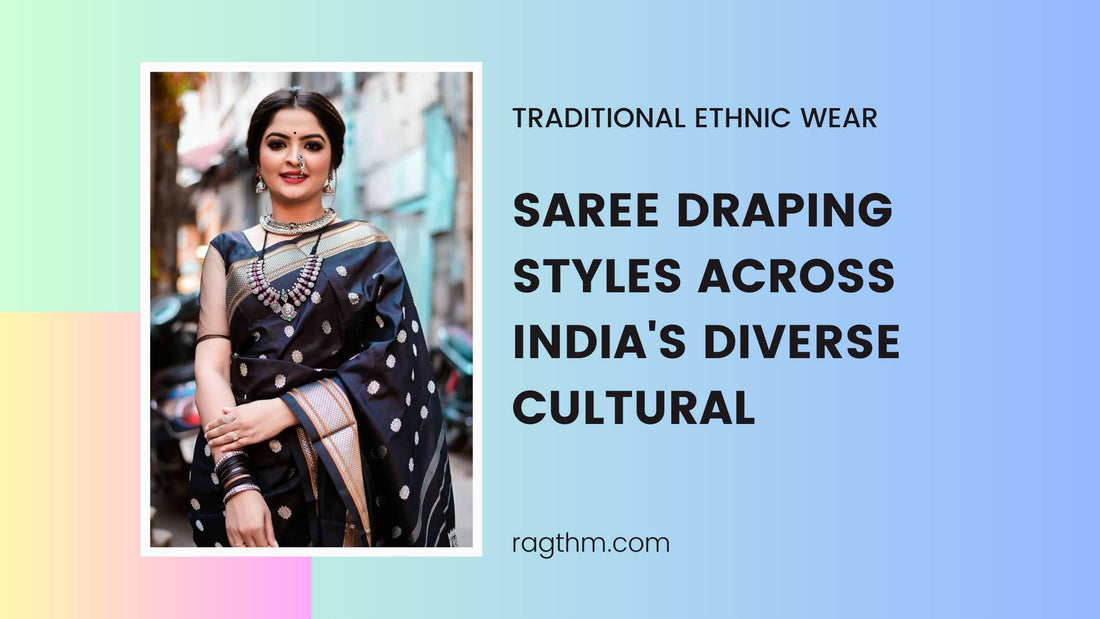
Unveiling the Splendor: Saree Draping Styles Across India's Diverse Cultural Landscape
Share
Exploring the Timeless Elegance: Saree Draping Styles from Diverse Regions of India
The Saree, With Its Rich History And Cultural Significance, Stands As An Embodiment Of India's Diversity And Elegance. One Of The Most Captivating Aspects Of The Saree Is Its Versatility In Draping Styles, Each Reflecting The Unique Heritage And Traditions Of Different Regions Across The Country. In This Blog, We Embark On A Journey To Explore The Exquisite Sari Draping Styles From Various Regions Of India, Celebrating The Artistry And Grace Woven Into Every Fold.

1. The Timeless Nivi Drape Of Andhra Pradesh And Telangana:
Originating From The Southern Regions Of India, The Nivi Style Is Renowned For Its Elegance And Simplicity. The Saree Is Draped With Pleats At The Waist, While The Pallu Is Gracefully Draped Over The Left Shoulder, Creating A Fluid And Flattering Silhouette. This Style Is Perfect For Formal Occasions And Has Gained Popularity Not Just In India But Also On Global Fashion Runways.
2. The Regal Maharashtrian Nauvari Drape:
The Maharashtrian Nauvari Saree, With Its Distinctive Nine-yard Length, Is A Symbol Of Tradition And Grace. The Drape Involves Intricate Pleating At The Waist, Allowing For Ease Of Movement, And The Pallu Is Elegantly Wrapped Around The Body, Creating A Regal Look. This Style Is Often Adorned During Festivals, Weddings, And Cultural Events, Showcasing The Rich Cultural Heritage Of Maharashtra.
3. The Elegant Bengali Tant Saree Draping:
Bengal's Traditional Tant Sarees Are Known For Their Lightweight Cotton Fabric And Artistic Borders. The Bengali Drape Involves Pleating The Saree At The Waist And Then Elegantly Securing The Pallu Over The Left Shoulder. This Style Exudes Grace And Is Often Worn During Festive Celebrations, Reflecting The Artistic Prowess Of Bengal's Weavers And Artisans.

4. The Vibrant Gujarati Seedha Pallu Style:
Gujarati Sarees Are Renowned For Their Vibrant Colors, Intricate Designs, And The Distinctive Seedha Pallu Drape. In This Style, The Pleats Are Tucked At The Back, And The Pallu Is Draped Gracefully Over The Right Shoulder, Creating A Striking Visual Appeal. Gujarati Women Often Adorn These Sarees During Navratri And Other Festive Occasions, Adding A Splash Of Color And Tradition To Their Attire.
5. The Graceful Assamese Mekhela Chador Draping:
Assam's Mekhela Chador Is A Two-piece Attire Comprising A Skirt-like Bottom (Mekhela) And A Draped Upper Garment (Chador). The Draping Style Involves Wrapping The Mekhela Around The Waist And Then Draping The Chador Over The Shoulders, Creating An Elegant And Traditional Look. The Motifs And Colors Used In Assamese Sarees Hold Cultural Significance, Reflecting The Region's Rich Heritage.
6. The Enchanting Kerala Mundu Neriyathu Style:
Kerala's Mundu Neriyathu Drape Is Synonymous With Simplicity And Elegance. The Traditional White Saree With Golden Borders Is Draped In A Unique Style, With Pleats At The Waist And The Pallu Elegantly Draped Over The Left Shoulder. This Style Reflects Kerala's Cultural Ethos And Is Often Worn During Weddings, Festivals, And Special Occasions.
The Diverse Saree Draping Styles From Different Regions Of India Not Only Showcase The Country's Rich Cultural Tapestry But Also Celebrate The Artistry And Craftsmanship Of Indian Weavers And Designers. Whether It's The Timeless Nivi Drape Of Andhra Pradesh Or The Regal Nauvari Style Of Maharashtra, Each Drape Tells A Unique Story Of Tradition, Elegance, And Heritage. Embracing These Saree Draping Styles Is Not Just A Fashion Statement But A Celebration Of India's Vibrant Cultural Heritage.